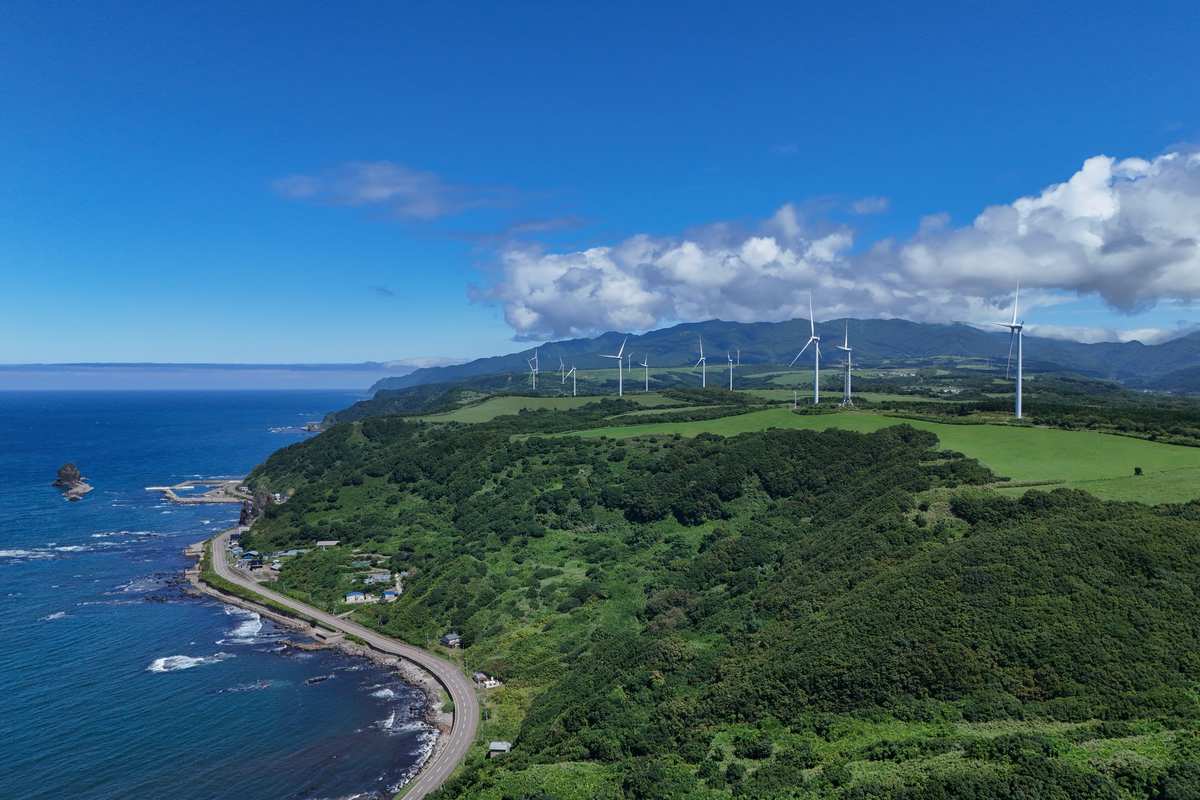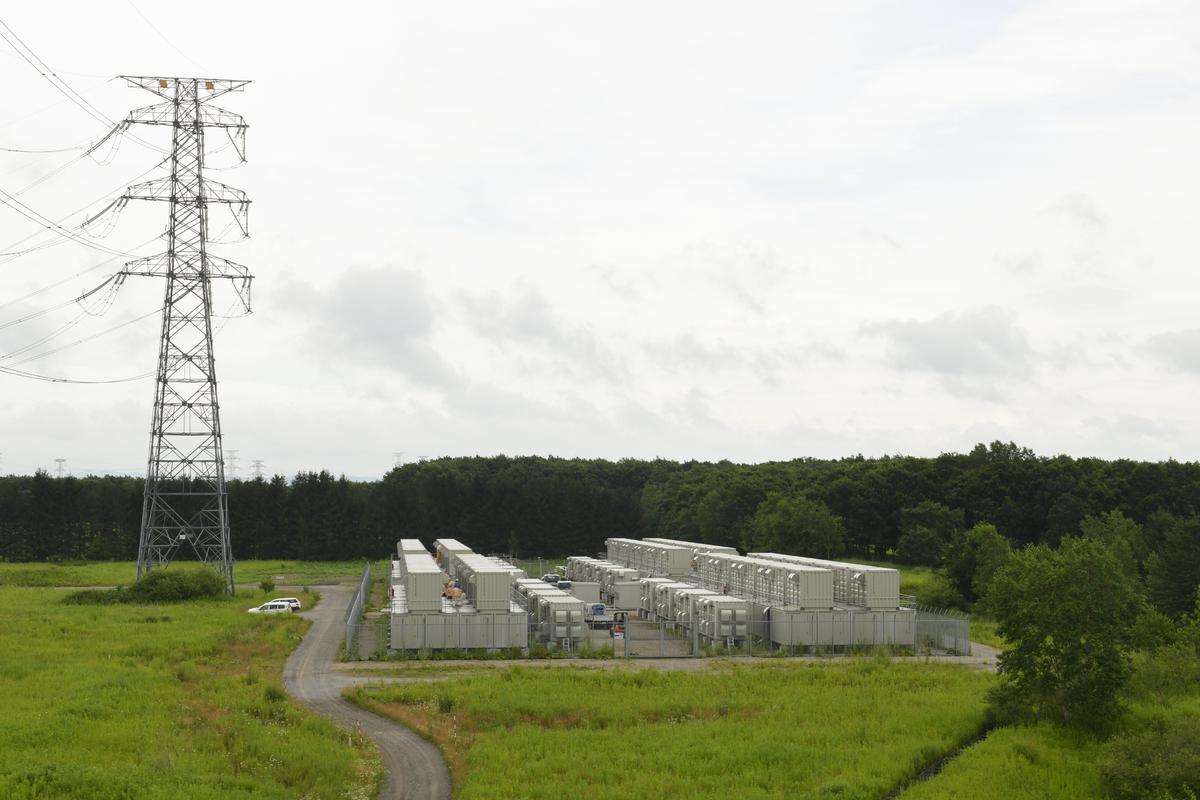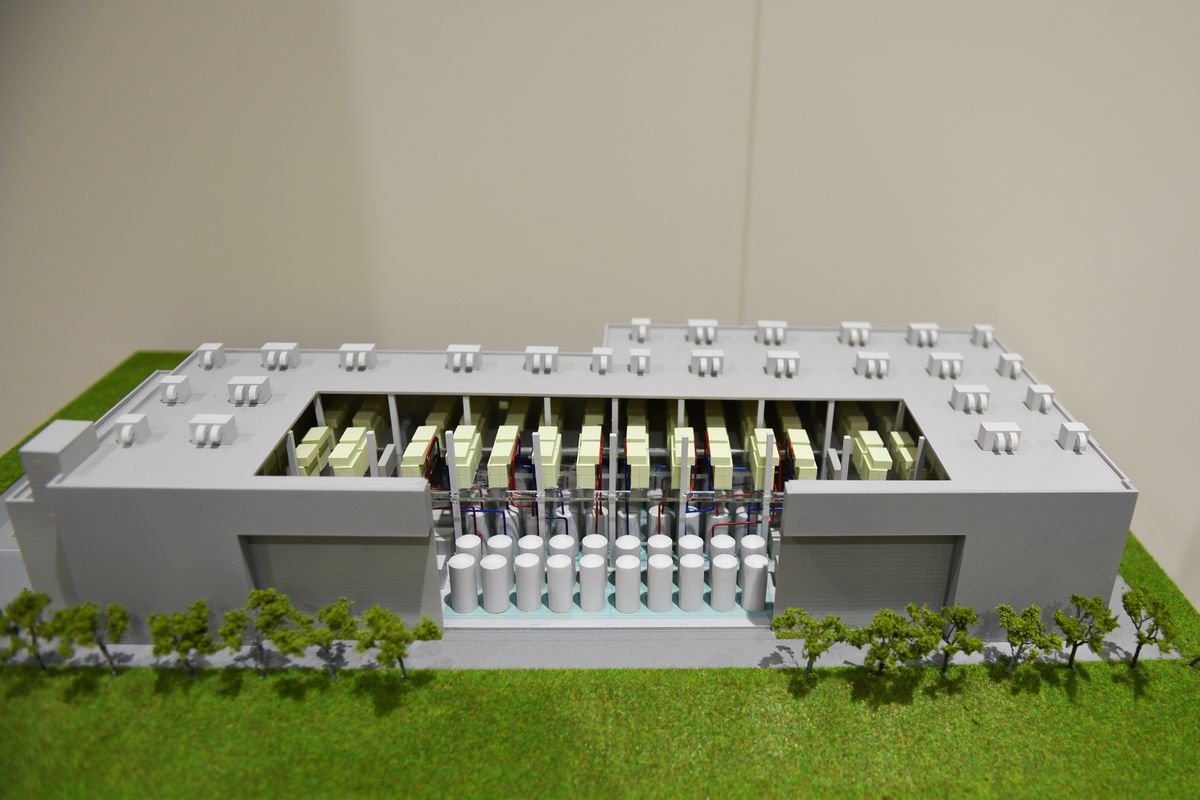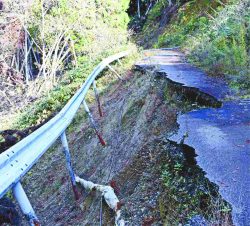
A wind farm in the town of Setana on Japan’s Hokkaido island. Energy produced by such turbines can go to waste if it can’t be stored.
12:18 JST, November 27, 2024
SAPPORO, Japan – Ocean winds whip across the beaches, hillsides and sprawling plains of Hokkaido. There’s enough wind energy here for Japan’s northernmost island to power itself and export clean electricity to the rest of the country.
But Hokkaido can’t harness all of that power unless it has a way to store energy when breezes are blowing and use it later when the gusts die down.
So, the island is turning to a new generation of batteries designed to stockpile massive amounts of energy – a critical step toward replacing power plants fueled by coal, gas and oil, which create a third of global greenhouse gas emissions.
Hokkaido is facing a problem that is starting to confront power grids around the world. For the past 150 years, utilities have stored energy in piles of coal or tanks of gas that can be burned on demand. But as countries switch from fossil fuels to clean energy, they need a new kind of backup system that can deliver power whenever someone flips a light switch, not just when the sun shines or the wind blows.
“Most utilities are definitely recognizing that if they’re adding renewables, they have to add storage,” said Vanessa Witte, a senior analyst at the energy data and analytics firm Wood Mackenzie.
After decades of development, the world has figured out how to make wind turbines and solar panels cheaply and at massive scale. They’re starting to make a dent in energy production, accounting for 15 percent of electricity globally, according to the International Energy Agency. But now, a few of the regions that have adopted wind and solar most aggressively are finding some of that energy goes to waste because they can’t store it.
Power companies are experimenting with new ways to hold on to that clean electricity, from stashing heat in vats of sand to supersizing the lithium-ion batteries that power laptops and cars. Some 30 miles from Sapporo, the Hokkaido Electric Power Network (HEPCO Network) is deploying flow batteries, an emerging kind of battery that stores energy in hulking tanks of metallic liquid.

Energy held in the flow batteries at the Hokkaido plant mirrors tanks of gas waiting to be burned. But it doesn’t create carbon pollution.
But the technology faces a raft of challenges, including high up-front costs and skeptical financiers. China and Russia dominate the market for vanadium, the metal that makes flow batteries durable and easy to maintain. “The supply chain for vanadium is extremely precarious,” said Kara Rodby, a battery analyst at the investment firm Volta Energy Technologies.
Still, flow batteries are making their debut in big real-world projects. Sumitomo Electric, the company that built the Hokkaido plant, has also built flow batteries in Taiwan, Belgium, Australia, Morocco and California. Hokkaido’s flow battery farm was the biggest in the world when it opened in April 2022 – a record that lasted just a month before China built one that is eight times bigger and can deliver as much energy as an average U.S. natural gas plant.
“It looks like flow batteries are finally about to take off with interest from China,” said Michael Taylor, an energy analyst at the International Renewable Energy Agency, an international group that studies and promotes green energy. “When China starts to get comfortable with a technology and sees it working, then they will very quickly scale their manufacturing base if they think they can drive down the costs, which they usually can.”
This is what the power plants of the future may look like: Instead of stashing coal and gas next to furnaces, they’ll use electrons to store energy inside of giant batteries.
***
The electrons: If the world is going to power itself with renewable energy, it needs to be ready at a moment’s notice.
All power grids have to pull off a delicate balancing act: There must always be about as many electrons flowing out of power plants as homes and businesses are using. If that balance ever falters, a community could face blackouts – or the utility could waste money making extra energy no one uses.
To make sure there’s always enough electricity to go around, energy companies rely on extra-polluting power plants called “peaker plants.” They get their name because they only run when electricity use hits its peak – for example, on a really hot day when everybody runs their air conditioners at once.
Peaker plants tend to be older, less efficient and more polluting than other plants. Most of the time, they sit idle. But in an emergency, they dump fuel – usually natural gas – into their furnaces to generate electricity fast. That keeps power flowing steadily to homes, businesses and factories, but it also pumps pollution into the air.
Wind turbines and solar panels don’t pollute, but they can’t make more electricity on demand. They only produce as much energy as the sun and the wind provide, which changes throughout the day or year depending on the weather.
One way to smooth out those bumps is to use batteries to store renewable energy when it’s plentiful and use it later when it becomes scarce.
The energy held in batteries mirrors the tanks of gas sitting next to a furnace waiting to be burned – except batteries can send out electricity even faster than a furnace can ramp up, and they don’t create carbon pollution.
Utilities are already building battery farms in regions that have added a lot of wind and solar power, such as California and Texas. So far, most of these batteries are lithium-ion, similar to the ones in a phone, laptop or electric car. Because they’re already built in bulk for other industries, they’ve become the default option for power companies.
But experts say there might be better options. Lithium-ion batteries are perfect for smartphones because they’re lightweight and fit in small spaces, even if they don’t last long and have to be replaced frequently. Utilities have a different set of priorities: They need to store millions of times more energy, and they have much more room to work with.
“If you think about utility-scale stationary applications, maybe you don’t need lithium-ion batteries. You can use another one that is cheaper and can provide the services that you want like, for example, vanadium flow batteries,” said Francisco Boshell, a researcher at the International Renewable Energy Agency.
***
The flow batteries: To power cities with renewable energy, you need bigger batteries.
Inside a sprawling two-story warehouse, HEPCO Network is storing electricity in 130 gleaming steel and plastic tanks. They can stockpile enough energy to power more than 27,000 Japanese homes for four hours.
Each 10,000-gallon tank holds tiny particles of the metal vanadium, which float around in water. This metallic soup holds the key to hoarding energy in massive quantities.
Vanadium is a shape-shifter. If you add or remove electrons from its atoms the element’s electrical charge will become more positive or negative, and its color changes from purple to green, blue and yellow. The metal’s rainbow color palette led Swedish chemist Nils Gabriel Sefstrom to name the element after Vanadis, the Scandinavian goddess of beauty. But vanadium’s ability to change its charge is what makes it so useful in a battery.
Here’s how it works:

A model of the flow battery system run by the Hokkaido Electric Power Network.
One tank holds vanadium with a more positive charge, while the other tank holds vanadium with a more negative charge. You can think of them like the + and – sides of the batteries sitting in a TV remote or a flashlight.
Every tank is hooked up to a set of pipes that pump vanadium into battery cells stacked in cabinets on the second floor.
Vanadium flows through each battery cell on either side of a membrane – which is why it’s called a flow battery.
When HEPCO Network wants to charge the batteries, it uses energy from wind turbines to move electrons from the positive side of the membrane to the negative side, which creates an imbalance: Now there are a lot more electrons crammed into the negative tank than the positive tank, and they’re itching to spread out evenly once again.
When HEPCO Network wants to use the energy stored inside the batteries, it lets electrons flow the other way. Their movement creates an electric current that can power homes and businesses across the island.
Flow batteries are designed to tap giant tanks that can store a lot of energy for a long time. To boost their storage capacity, all you have to do is build a bigger tank and add more vanadium. That’s a big advantage: By contrast, there’s no easy way to adjust the storage capacity of a lithium-ion battery – if you want more storage, you have to build a whole new battery.
The flow batteries in this plant are designed to store energy for about four hours of use, which is on par with lithium-ion batteries. But Sumitomo Electric says it expects future projects will aim to double that duration to eight to 10 hours. That’s about what they’d need to last overnight when solar panels are dormant, or to fill in the gaps between gusts of wind.
One major barrier to building more of these battery farms is finding enough vanadium. Three-quarters of the world’s supply comes as a by-product from 10 steel mills in China and Russia, according to Rodby, who got her PhD at the Massachusetts Institute of Technology studying the design and market for flow batteries. Australia, South Africa and the United States also produce vanadium, but in much smaller quantities.
Mines that have been proposed could boost supply. And some flow battery start-ups are trying to sidestep the vanadium problem entirely by using different materials that are easier to buy.
The other hurdle is their up-front cost. Vanadium flow batteries are at least twice as expensive to build as lithium-ion batteries, Rodby said, and banks are hesitant to lend money to fund an unfamiliar technology.
But experts say flow batteries can be cheaper in the long run because they’re easier to maintain and last longer. A lithium-ion battery might have to be replaced after 10 years, but Rodby says flow batteries can last much longer. “There really is no finite lifetime for a flow battery in the way there is for lithium-ion,” Rodby said.
Sumitomo Electric President Osamu Inoue said his company guarantees its flow batteries will last 20 years – but the vanadium inside can be reused forever in future batteries. The company’s oldest commercial batteries have been running for 11 years so far.
***
The grid: Wind and solar power are coming. Batteries can keep them from causing chaos on the power grid.
Just outside the building that houses the gleaming floor-to-ceiling tanks, Sumitomo has built a new version of its flow batteries, this time tucking all of their components into shipping containers. That makes them faster and cheaper to build than the $100 million indoor demonstration plant next door.
The batteries connect to homes, businesses and power plants all over Hokkaido by plugging into the power grid.
These batteries help Hokkaido keep a steady balance between the amount of energy its power plants generate and the amount of electricity its homes and businesses use. But they’re not the only way to maintain that balance: While Hokkaido is on a battery-building spree, it’s also beefing up undersea power lines to share electricity with the rest of Japan.
So far, it’s working: Even though Hokkaido gets nearly a fifth of its electricity from wind and solar, it doesn’t face blackouts and it wastes almost zero energy.
Having a stable grid allows Hokkaido to keep building more renewable energy, bringing it closer to its goal of cutting power plant emissions to zero by 2050. The flow batteries sitting in the shipping containers outside Sapporo paved the way for HEPCO Network to add 15 new wind farms around Hokkaido. The turbines generate about 3 percent of the island’s electricity without pollution.
Experts say the world will need to build many more batteries like these to stay on track to cut greenhouse emissions to zero by 2050. Over the next six years, utilities will have to build 35 times as many batteries as there are today to soak up all extra renewable energy that will come online, according to the International Energy Agency.
The point of all this battery building is on display off the coast of Hokkaido.
Earlier this year, Japan’s biggest offshore wind farm opened just off the coast of Ishikari, a seaside town on the outskirts of Sapporo. The 14 turbines – each about 20 stories tall – face across the water from a natural gas plant that would shut down if Hokkaido’s clean energy plans succeed.
"News Services" POPULAR ARTICLE
-

American Playwright Jeremy O. Harris Arrested in Japan on Alleged Drug Smuggling
-

Japan’s Nikkei Stock Average as JGB Yields, Yen Rise on Rate-Hike Bets
-

Japan’s Nikkei Stock Average Licks Wounds after Selloff Sparked by BOJ Hike Bets (UPDATE 1)
-

Japan’s Nikkei Stock Average Buoyed by Stable Yen; SoftBank’s Slide Caps Gains (UPDATE 1)
-

Japanese Bond Yields Zoom, Stocks Slide as Rate Hike Looms
JN ACCESS RANKING
-

Tokyo Economic Security Forum to Hold Inaugural Meeting Amid Tense Global Environment
-

Keidanren Chairman Yoshinobu Tsutsui Visits Kashiwazaki-Kariwa Nuclear Power Plant; Inspects New Emergency Safety System
-

Imports of Rare Earths from China Facing Delays, May Be Caused by Deterioration of Japan-China Relations
-

University of Tokyo Professor Discusses Japanese Economic Security in Interview Ahead of Forum
-

Japan Pulls out of Vietnam Nuclear Project, Complicating Hanoi’s Power Plans





















